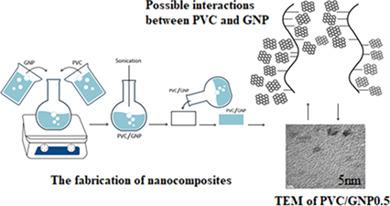当前位置:
X-MOL 学术
›
Polym. Compos.
›
论文详情
Our official English website, www.x-mol.net, welcomes your
feedback! (Note: you will need to create a separate account there.)
Mechanical, thermal, and micro‐ and nanostructural properties of polyvinyl chloride/graphene nanoplatelets nanocomposites
Polymer Composites ( IF 4.8 ) Pub Date : 2020-06-08 , DOI: 10.1002/pc.25669 Ferda Mindivan 1, 2 , Meryem Göktaş 2, 3 , Ali S. Dike 4
Polymer Composites ( IF 4.8 ) Pub Date : 2020-06-08 , DOI: 10.1002/pc.25669 Ferda Mindivan 1, 2 , Meryem Göktaş 2, 3 , Ali S. Dike 4
Affiliation

|
This article describes micro‐ and nanostructural, mechanical, and thermal properties of nanocomposites based on polyvinyl chloride (PVC) and graphene nanoplatelets (GNP). The primary objective of this study was to extend restricted application area of PVC due to its low thermal stability and limited mechanical properties. GNP‐filled PVC nanocomposites were prepared (0, 0.1, 0.3, 0.5, and 1.0 wt%) by colloidal blending method and characterized in detail. The highest value of the tensile strength 13.73 MPa (an increase of 58%) and the highest value of microhardness 83.42 MPa (an increase of 82%) were obtained with GNP loading content of 0.5 wt% compared neat PVC. The mechanical properties started to decrease at loading higher than 0.5 wt%; however, the thermal properties continued to increase. The differential scanning calorimetry and Fourier transform infrared analysis results of this nanocomposite confirmed that the increase in glass transition temperature from 34.99°C to 44.36°C and the decrease in the height of functional groups peaks proved to prevented segmental relaxation and intermolecular vibrations of PVC, respectively. Thermogravimetric analysis results were showed that the percentage of carbonaceous residue increased to 15.77% by increasing the GNP content from 0.1 to 0.5 wt%. As a result, the best GNP loading was at 0.5 wt% for PVC/GNP nanocomposites where mechanical and thermal properties of PVC/GNP were both enhanced.
中文翻译:

聚氯乙烯/石墨烯纳米片纳米复合材料的机械,热以及微观和纳米结构性质
本文介绍了基于聚氯乙烯(PVC)和石墨烯纳米片(GNP)的纳米复合材料的微观和纳米结构,机械和热性能。这项研究的主要目的是由于其低的热稳定性和有限的机械性能而扩大了PVC的受限应用领域。通过胶体共混法制备了GNP填充的PVC纳米复合材料(0、0.1、0.3、0.5和1.0 wt%),并进行了详细表征。与纯PVC相比,GNP含量为0.5 wt%时,抗张强度的最大值为13.73 MPa(增加58%),显微硬度的最大值为83.42 MPa(增加82%)。当负载大于0.5wt%时,机械性能开始下降;但是,热性能继续提高。该纳米复合材料的差示扫描量热法和傅立叶变换红外分析结果证实,玻璃化转变温度从34.99°C升高至44.36°C,官能团峰高度的降低证明可防止PVC的分段松弛和分子间振动,分别。热重分析结果表明,通过将GNP含量从0.1重量%增加到0.5重量%,碳质残渣的百分比增加到15.77%。结果,对于PVC / GNP纳米复合材料,最佳的GNP负载量为0.5wt%,其中PVC / GNP的机械和热性能均得到增强。证实36℃和官能团峰高度的降低分别防止了PVC的节段松弛和分子间振动。热重分析结果表明,通过将GNP含量从0.1重量%增加到0.5重量%,碳质残渣的百分比增加到15.77%。结果,对于PVC / GNP纳米复合材料,最佳的GNP负载量为0.5wt%,其中PVC / GNP的机械和热性能均得到增强。证实36℃和官能团峰高度的降低分别防止了PVC的节段松弛和分子间振动。热重分析结果表明,通过将GNP含量从0.1重量%增加到0.5重量%,碳质残渣的百分比增加到15.77%。结果,对于PVC / GNP纳米复合材料,最佳的GNP负载量为0.5wt%,其中PVC / GNP的机械和热性能均得到增强。
更新日期:2020-06-08
中文翻译:

聚氯乙烯/石墨烯纳米片纳米复合材料的机械,热以及微观和纳米结构性质
本文介绍了基于聚氯乙烯(PVC)和石墨烯纳米片(GNP)的纳米复合材料的微观和纳米结构,机械和热性能。这项研究的主要目的是由于其低的热稳定性和有限的机械性能而扩大了PVC的受限应用领域。通过胶体共混法制备了GNP填充的PVC纳米复合材料(0、0.1、0.3、0.5和1.0 wt%),并进行了详细表征。与纯PVC相比,GNP含量为0.5 wt%时,抗张强度的最大值为13.73 MPa(增加58%),显微硬度的最大值为83.42 MPa(增加82%)。当负载大于0.5wt%时,机械性能开始下降;但是,热性能继续提高。该纳米复合材料的差示扫描量热法和傅立叶变换红外分析结果证实,玻璃化转变温度从34.99°C升高至44.36°C,官能团峰高度的降低证明可防止PVC的分段松弛和分子间振动,分别。热重分析结果表明,通过将GNP含量从0.1重量%增加到0.5重量%,碳质残渣的百分比增加到15.77%。结果,对于PVC / GNP纳米复合材料,最佳的GNP负载量为0.5wt%,其中PVC / GNP的机械和热性能均得到增强。证实36℃和官能团峰高度的降低分别防止了PVC的节段松弛和分子间振动。热重分析结果表明,通过将GNP含量从0.1重量%增加到0.5重量%,碳质残渣的百分比增加到15.77%。结果,对于PVC / GNP纳米复合材料,最佳的GNP负载量为0.5wt%,其中PVC / GNP的机械和热性能均得到增强。证实36℃和官能团峰高度的降低分别防止了PVC的节段松弛和分子间振动。热重分析结果表明,通过将GNP含量从0.1重量%增加到0.5重量%,碳质残渣的百分比增加到15.77%。结果,对于PVC / GNP纳米复合材料,最佳的GNP负载量为0.5wt%,其中PVC / GNP的机械和热性能均得到增强。







































 京公网安备 11010802027423号
京公网安备 11010802027423号